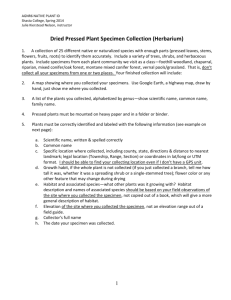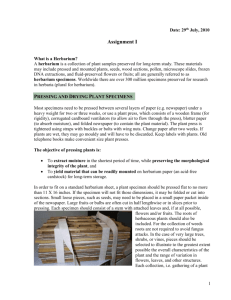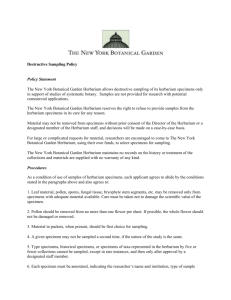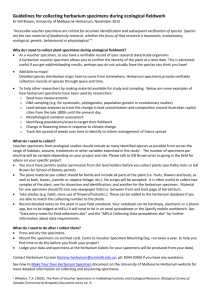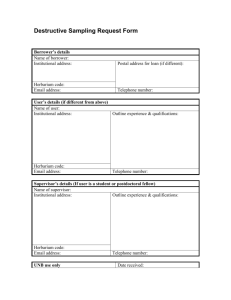Nancy Poole Rich Herbarium Collections Policy
advertisement
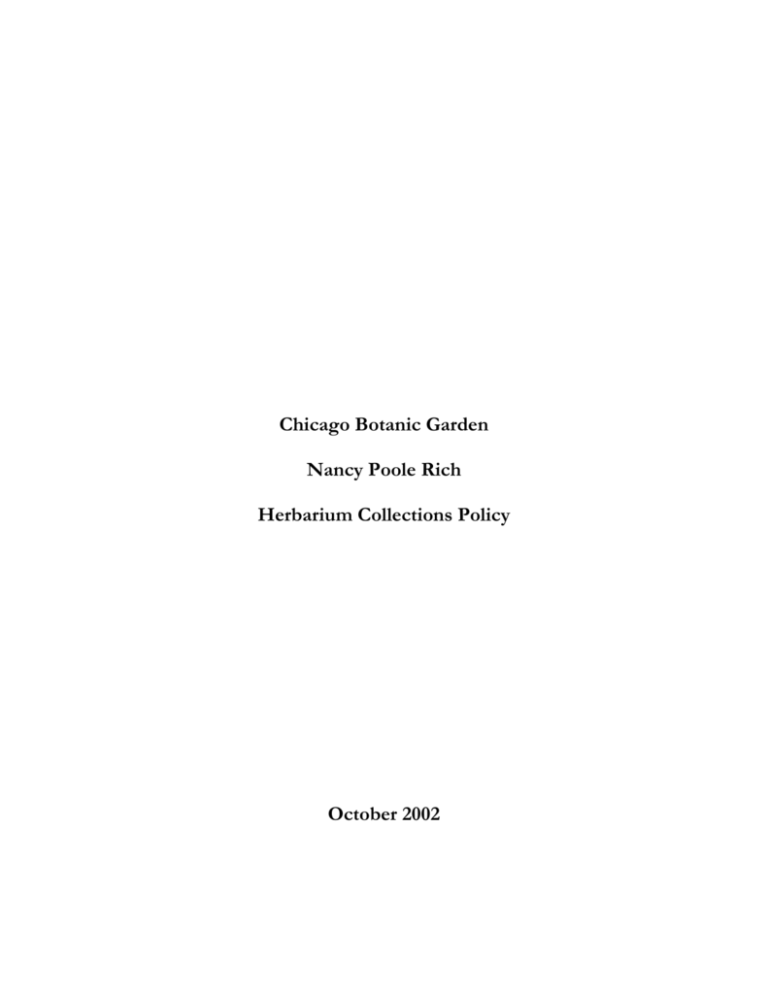
Chicago Botanic Garden Nancy Poole Rich Herbarium Collections Policy October 2002 Herbarium Collection Policy MISSION The Nancy Poole Rich Herbarium of the Chicago Botanic Garden is a scientific, taxonomic and educational resource managed by the Conservation Science Department. It serves the conservation mission of the Garden by housing a significant and growing reference collection of the native and introduced flora of the Chicago region and the Upper Midwest as well as a voucher collection of plants studied in the Conservation Science Department. It supports the horticultural mission of the Garden by housing a representative collection of voucher specimens of the Garden’s living collections, horticultural research programs and plant exploration programs. It supports the education mission of the Garden by providing resources to support the programs of the School of the Botanic Garden. SCOPE OF COLLECTION The Herbarium is a repository of preserved and mounted vouchered plants comprising specimens of regional flora, particularly the Flora of Cook County; vouchers for research studies, including Conservation Science, Plant Evaluation, and Plant Breeding Programs; verified horticultural specimens from the Garden’s living collections; and specimens collected on Garden-sponsored plant explorations. Although the Herbarium houses primarily vascular plants, it also contains an insect collection from the grounds of the Chicago Botanic Garden, stored in two cases; small collection of fungi and of bryophytes from McDonald Woods; and a lichen collection of 50 specimens collected in the Cook County Forest Preserve system. The Herbarium collection currently comprises approximately 12,000 specimens, all of which are owned by the Garden. Its core collection includes: A reference identification collection of the native and naturalized flora of the Chicago Wilderness region, particularly the Flora of Cook County Project, which includes specimens collected from Chicago Botanic Garden’s native habitats, and from other parts of the Upper Midwest, including voucher specimens from the Conservation Science program. The regional flora collection contributes to the Garden’s partnership in Chicago Wilderness by documenting regional biodiversity. (Flora of Cook County: 3,000; other native/naturalized regional flora: 2,700. Total: 5,700.) Verified ornamental horticultural specimens from the Garden's living display collections, particularly the genera Cornus, Amelanchier, Cotoneaster, Euonymus, Malus, Spiraea, Viburnum. (1,600) Specimens collected on Garden sponsored plant explorations. (1,000) The Chicago Botanic Garden Teaching Collection consists primarily of intern-collected plant material, including ornamental, native and invasive plant specimens. These specimens are used primarily for intern instruction as well as for use in horticultural and botanical classes taught through the School of the Botanic Garden. (290) In addition, DNA vouchers (cuttings of plant tissue) are now routinely taken from herbarium voucher specimens of the Conservation Science Department. Other horticultural and research herbarium collections will have DNA vouchers taken as deemed appropriate. These specimens are stored separately in a freezer, at minus 75 degrees Celsius, for purposes of future genetic work. DNA vouchers are part of the Herbarium collection. Special non-accessioned collections include: The North Branch Restoration Project (NBRP) collection consists of native plants collected on Cook County Forest Preserve land in the region of the North Branch of the Chicago River. NBRP members or other volunteers are welcome to make appointments to use this collection. We house this collection through an arrangement with the NBRP; however, these specimens are not owned by the Garden. (175) A limited collection of fungi and insects. ACCESSION POLICY The Herbarium accessions voucher specimens from staff research, verified specimens from staff and collaborator collections, and appropriate gift or exchange specimens from other institutions from the Garden's primary display areas. This ensures that other researchers will have and the best possible understanding of materials with which the Garden's work was carried out. The Manager of the Herbarium initiates accessioning. Any exceptions to the stated mission of the Herbarium must be approved by the Director of Conservation Science. Currently each 100% acid free herbarium sheet is pre-numbered with an accession number and the Chicago Botanic Garden logo. After specimens are affixed to the paper the label data is entered into a computer database. Each year a report is generated detailing the new accessions into the Herbarium. All herbarium computer records are currently backed up and duplicated at the end of data entry session and stored off-site. All available label data are kept, including: plant family, genus, species, authority, common name, detailed plant and habitat descriptions, plant associates, exact location where collected including GPS coordinates since 1998, date of collection, and collector’s name and number. Unlike libraries, herbaria have not been inventoried historically. CONSERVATION OF COLLECTION The collection is stored in 30 standard metal Herbarium cases, each with a capacity to hold approximately 1100 specimens. The Herbarium can eventually store nearly 33,000 specimens. Each cabinet has closed-cell elastomeric seals for high-level collection protection. The cabinets also have chemical resistant seals and coatings. The room in which the cases are stored is air-conditioned. Every effort is made to keep the Herbarium collection insect free. Before being placed into the collection each specimen is frozen for at least 72 hours at minus 34.5 degrees Celsius. This effectively kills any insect larvae which may be present. After the specimens are stored they are continually assessed and monitored for insect infestations. For example, cigarette beetles (Lasioderma serricorne) most frequently feed on dried herbarium specimens. If allowed to enter herbarium cabinets they can cause considerable damage to the specimens. The most effective control is a system of randomly placed sex-pheromone traps. Insects are attracted to the pheromone, enter the trap and are killed. Our traps are checked every two weeks and replaced every three months. If insects are detected, the affected portion of the collection is removed and again frozen. The DNA vouchers are kept in a freezer at minus 75 degrees Celsius in a room nearby the Herbarium. DEACCESSION POLICY Occasionally a specimen will be removed from the collection because it is damaged, it is a duplicate, or it is determined by the Manager of the Herbarium to no longer have value to the collection. If the specimen is damaged beyond repair it will be destroyed. If the specimen is a duplicate or no longer of value, every effort will be made to place the specimen in another institution's herbarium such as those at The Morton Arboretum or the Illinois Natural History Survey. Once specimens are removed from the collection, both their accession numbers and computer records are also removed from the Garden’s documentation system. Once deleted from the system the files are then archived. LOANS Within the Chicago Botanic Garden: specimens may be borrowed for educational purposes by other departments within the Garden. A loan record is created for each transaction. Before leaving the Herbarium, each specimen is supported by cardboard and is placed inside a plastic zip-lock bag for protection. Borrowers are requested to keep the specimen inside that bag for the duration of the loan. Outside Collaborations: specimens are only loaned to other research institutions, which can properly house and maintain the specimens for the duration of their study. Ordinarily loans are not made to individuals. Requests for loans must be made to the Manager of the Herbarium. Upon approval, appropriate loan forms are completed and retained until the specimen is returned. Loans are made for one year or less. When circumstances warrant, this period may be extended on request. It is requested that each sheet be annotated and that reprints of any published articles resulting from these specimens be sent to us. All materials are packed and shipped according to accepted herbarium procedures. SECURITY The Herbarium is housed in a 16 ft. by 15 ft. room accessible only by entering the plant identification laboratory. Doors to both rooms are locked each evening. All major equipment, including microscopes, is insured. The herbarium specimens are not insured. NATURAL DISASTER PROVISIONS In the event of a natural disaster such as flood or fire, the herbarium collection is protected in several ways. An automatic sprinkler system for fire suppression in the Herbarium ceiling is inspected annually. These herbarium cases have waterproof caps that will prevent sprinkler system water from entering them. The steel cases are fire resistant to a certain temperature. Closed-cell elastomeric seals lining the case doors inhibit entry of both oxygen (needed for combustion) and water. Finally, the DNA vouchers in the freezer are protected by a backup generator should electric power be cut off. SUSTAINABILITY Because of its relevance to the Garden’s mission, there is an institutional commitment to maintain and sustain the Herbarium. It is expected, however, that the Herbarium will generate earned and raised revenue as possible. There is a small revenue potential in service fee charges. Raised revenue in the form of grant funds for special projects or aspects of the operations have been received in the past, and these funding opportunities will continue to be pursued. For example, Chicago Botanic Garden is participating in an Institute of Museum and Library Services grant with The Morton Arboretum and the Field Museum of Natural History to create a website with access to each institution’s herbarium database. This website will also feature images of specimens representing regional native flora. FUTURE GOALS Long term goals for the Herbarium collection have been developed and evaluated as a critical element of the Conservation Science Department & Institute for Plant Conservation Biology Green Book. Expansion goals of the Herbarium have been reviewed in reference to the research, teaching and facilities needs of that program as well as to the vouchering, research and teaching needs of the Garden’s programs in native habitats, horticulture and education.



